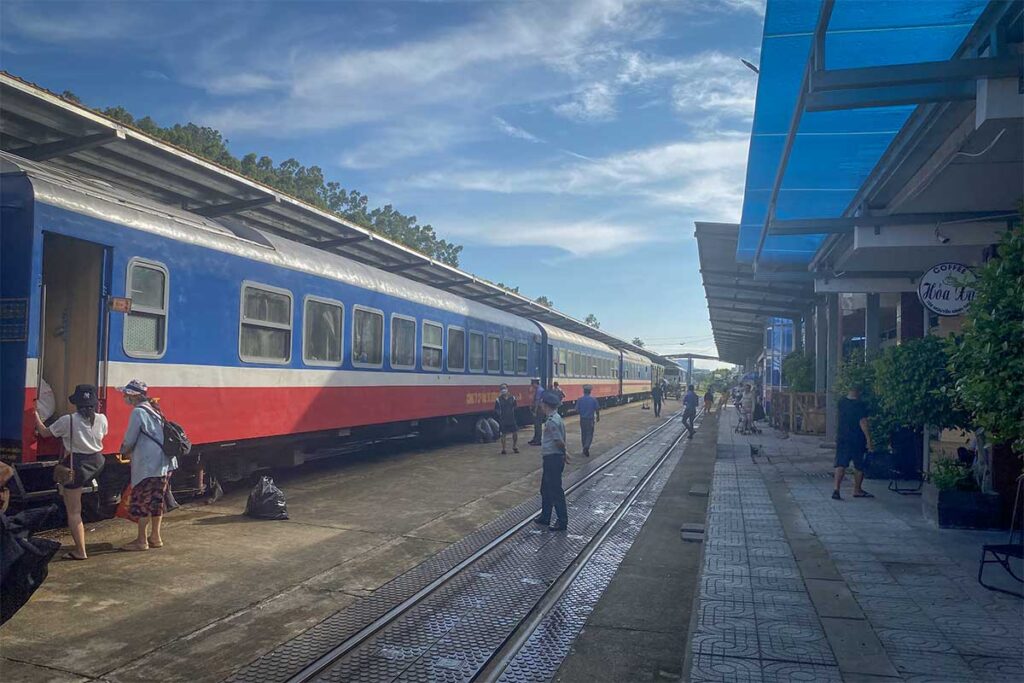About Dieu Tri Train Station?
Quick facts
Diêu Trì Train Station is one of the major stops on Vietnam’s North–South Reunification Line, making it an important hub for long-distance travel. A short branch line connects it directly to Quy Nhon Station in the city center, though only a handful of local services use that spur. The station itself is located about 11 km from central Quy Nhon, usually a 10–25 minute drive depending on traffic.

Layout & facilities
The station is functional rather than modern. You’ll find several ticket counters, a basic waiting area with fans (not full air-conditioning), restrooms, and loudspeaker announcements that are mostly in Vietnamese, with some in English.

Food and drinks are limited inside, but just outside the station small kiosks and street stalls sell banh mi and snacks—handy for grabbing something before your train journey. Seating is limited and the waiting areas can feel hot in summer, especially if your train is delayed.
Accessibility notes
Platforms are reached via steps or ground-level crossings, which can be tricky if you’re carrying heavy luggage or traveling with limited mobility. Assistance is available but not always obvious, so it’s best to arrive early to avoid last-minute stress. Like many Vietnamese railway stations, accessibility features are basic rather than comprehensive.

Dieu Tri vs. Quy Nhon Station
For most travelers, Diêu Trì is the main railway gateway to Quy Nhon because nearly all north–south trains stop here. By contrast, Quy Nhon Station—closer to the city center—sits on a spur line and sees only limited departures, usually short SQN shuttle services. If you’re booking a long-distance journey to or from Quy Nhon, Diêu Trì is the station you’ll almost always be using.
How to travel between Quy Nhon and Diêu Trì Train Station
For travelers, Diêu Trì Train Station is mainly useful as the rail gateway to and from Quy Nhon. The station sits about 11 km from the city center, which usually takes between 15 and 25 minutes by road depending on traffic. There are a few ways to cover this stretch, though most visitors choose a taxi or ride-hailing app.
Taxi or Grab
Taxis and Grab cars are the easiest and most common option. Expect to pay roughly 200,000–300,000 VND for a one-way ride, depending on traffic, time of day, and whether you book via Grab or a metered taxi. Cars are usually available right outside the station, and in Quy Nhon you can order one through the Grab app.
Local bus
There are public buses running between Quy Nhon and Diêu Trì, but they’re not very practical for travelers. Schedules change, information is mostly in Vietnamese, and the buses don’t always stop directly at the station entrance. If you’re traveling light, it can be a very cheap option, but for most visitors it’s easier to stick with a taxi or Grab.
Popular train connections from Dieu Tri
Travelers using Diêu Trì Station can choose between different seat and berth classes, depending on distance and comfort level. Options generally include hard seats, soft seats, and sleeper berths—either 6-berth “hard” cabins or 4-berth “soft” cabins. All carriages are air-conditioned. For long journeys, a soft sleeper is recommended, while soft seats are fine for daytime rides of just a few hours. Schedules can vary seasonally, so always reconfirm times on the official Vietnam Railways website or a trusted booking platform.
Dieu Tri ↔ Da Nang / Hoi An area
Several SE trains link Diêu Trì with Da Nang, taking around 6 hours. From Da Nang Station, you can reach Hoi An by taxi or shuttle bus in about 45 minutes. This route is a popular way to continue north toward Central Vietnam’s cultural highlights.
Dieu Tri ↔ Nha Trang
The stretch south to Nha Trang takes about 4–5 hours by SE train. This short journey is convenient for combining Quy Nhon with another coastal destination, with both day and evening departures available.
Dieu Tri ↔ Ho Chi Minh City (Saigon)
The journey south to Ho Chi Minh City takes around 11–12 hours. Overnight options are common, with soft sleeper cabins offering the most comfortable experience. Expect late-night or early-morning departures depending on the train.
Dieu Tri ↔ Hanoi
Heading north, Diêu Trì to Hanoi takes a full 21–23 hours. A soft sleeper berth is the most practical choice for this long ride, and you may want to break up the journey with stops along the way in cities like Hue or Da Nang.
Dieu Tri ↔ Quy Nhon Station (spur line)
There is a short spur line connecting Diêu Trì to Quy Nhon Station, but service is limited to local SQN shuttles, often only a couple of trains per day. Because schedules change and can be inconvenient, most travelers use a taxi or Grab between Diêu Trì and central Quy Nhon, which is usually faster and more flexible.
Note: Train times and availability change regularly, especially during holidays. Always double-check your intended departure on the official website or app before traveling.
How to book train tickets
Official channels
The most reliable place to check schedules and buy tickets is through the official Vietnam Railways website or its DSVN app. Both show real-time availability, allow you to choose seat or berth classes, and issue e-tickets that can be scanned at the station. The interface is straightforward, though mainly in Vietnamese with partial English translations.
Third-party platforms
If you prefer an easier booking experience in English, platforms like 12Go Asia or Vexere are good alternatives. They accept international payment cards and provide clear explanations of seat types and train classes. These services often add a small booking fee, and cabin categories may be labeled slightly differently than on the official site.
At the station
Tickets can also be purchased directly at Diêu Trì’s counters. Staff will usually ask for your passport details when issuing tickets. Buying at the station works well for spontaneous travel, but for busy dates such as weekends, holidays, or the Tet New Year period, tickets may sell out quickly—so advance booking is highly recommended.
The Vietage by Anantara (luxury rail that calls at Dieu Tri)
The Vietage by Anantara is a luxury rail carriage that connects Quy Nhon via Diêu Trì Station, making this otherwise simple hub the gateway for Vietnam’s most exclusive train journey. Two carriages operate daily in opposite directions: one departs Da Nang at 8:00 am and reaches Diêu Trì around 2:10 pm before continuing to Nha Trang, while the other leaves Nha Trang at 1:25 pm, arrives at Diêu Trì at 5:37 pm, and continues to Da Nang late in the evening. With only 12 seats per carriage, passengers enjoy gourmet dining, free-flow drinks, spa treatments, and Wi-Fi in a vintage-inspired setting. For exact timings and availability, it’s best to check the official Vietage website before booking.
Tips for using Dieu Tri Station
- Arrive early: Get to the station at least 20–30 minutes before departure. Platforms can be crowded, signage is limited, and it helps to have extra time to find your carriage calmly.
- Prepare for the heat: Waiting areas are simple, often cooled only by ceiling fans. In summer it can be hot, so bring a bottle of water and some snacks. Don’t expect full air-conditioning.
- Have your ticket ready: Keep your paper ticket or e-QR code on hand, and pay close attention to loudspeaker announcements. Platform changes can be last-minute, and announcements may be hard to hear.
- Be smart with transport: After arrival, taxis and motorbike drivers will approach you outside. Stick to known brands, use Grab when available, or agree on a fare before you get in a vehicle without a meter.
- Make long trips comfortable: For overnight journeys, a soft sleeper is the best choice. Pack a light layer or earplugs to handle cool A/C and nighttime noise.
Learn more: For broader advice on routes, classes, and what to expect across the country, see our complete Vietnam train travel guide.



